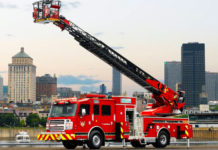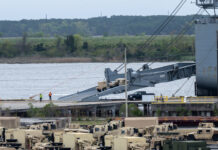By James O’Neill, New York Daily News via NYPD News
Each time we have had a terror attack in New York City, like the bombing attack on Monday morning, the truck attack last Halloween, or the Chelsea bombing on my first day as police commissioner in September 2016, I have talked about the shared responsibilities for preventing and responding to these attacks.
Usually, I am referring to the help that the police need from the public.
We want people to pay attention to their surroundings and to what is unfolding around them, to be ever vigilant, and to tell us when they see something suspicious, so that the police have opportunity to investigate.
Sometimes, I’m referring to the FBI, and the invaluable work they do with the NYPD in the Joint Terrorism Task Force.
The FBI/NYPD team has foiled more than 20 plots against our city since 9/11, and they are continuously running down every lead, every report, and every hint of a terrorist threat.
As we all know, New York City is the terrorist target of choice in the United States.
In national risk assessments, the city leads the list, both in terms of the likelihood of an attack and the risk of loss should an attack occur.
This situation is only compounded by the emergence of lone-wolf terrorists who act without direct orders from terrorist organizations, but are motivated and learn tactics through their covert research online.
To foil these threats, we need the widest possible search team and the strongest possible network of counterterror capabilities.
So, the shared responsibilities for protecting our city extend far beyond the public and the FBI to technology companies on the one hand and the United States Congress on the other.
The technology companies have fiercely resisted law enforcement’s legitimate need, with legally obtained court orders, to open the cell phones and computers of terrorists.
This included challenging a warrant after the San Bernardino terrorist attack and shooting.
(Tech giant will fight an order to unlock a user’s iPhone, saying to do otherwise would create a back door that could potentially be used on other future devices. Courtesy of CBC News and YouTube. Posted on Feb 17, 2016)
Networking is an integral part of the new terrorism environment, whether its communication between conspirators or just web browsing by a wannabe.
So it is critically important that law enforcement, with the appropriate court orders, have access to the terrorist’s devices, digital history, and encrypted communications.
Anything else makes building a case against a terrorist or disrupting a larger cell far more difficult.
The technology companies should step up to their shared responsibilities.
Additionally, as terrorists urge their followers to engage in “active shooter” tactics, the House has passed a bill that would force New York City to honor any concealed carry license from any state, no matter how lax their licensing standard may be.
This includes states that do not even require a license to carry a firearm.
Effectively, New York police could stop four terrorists with guns acting suspiciously who presented licenses from Virginia, where almost anyone can get a gun, and be forced to let them go, even though today, that same gun possession would be a felony.
Congress needs to focus on real threats, rather than creating new ones.
Congress also has the shared responsibility of sustaining the federal funding that has helped the city create some the most important components of our exhaustive counterterror capability.
That funding has been under the budget knife recently.
President Trump’s budget proposal early this year envisioned cutting counterterror funding to cities by a staggering 45% and zeroing out training funding.
The New York State congressional delegation has fought valiantly to keep this much-needed funding in place, and Senate and House committees have restored large parts of it, although the current funding for training is less than one-seventh of what the city requested.
Federal funds have supported training in active shooter scenarios, greatly expanding the department’s capacity to engage with a concerted terrorist attack like the Bataclan attack in Paris.
This training also provides officers with instruction in life-saving medical techniques that could be vital to reducing fatalities in a major attack, especially in the minutes before medical personnel can safely enter a scene.
With budget cuts, active shooter training would have to be reduced by several hundred officers a year.
Training in explosive, chemical, biological, and radiological threats is also in danger, as is the purchase of protective equipment for officers.
Even now, the federal government proposes to eliminate the Department of Homeland Security’s New York office that certifies and calibrates our most sophisticated radiation detection sensors.
Given the possible forms that a terror attack might take, we have to train, equip and prepare for everything, including bio warfare or a dirty bomb.
Federal funding has been invaluable, and cuts would undermine our readiness.
Also at risk would be our ongoing expansion of our Domain Awareness System to the outer boroughs.
DAS, originally centered in lower Manhattan, is a network of cameras, license plate readers, radiological sensors, and environmental sensors, all managed and synchronized with information technology.
Federal funding was critically important to its design and implementation, and continued federal support is necessary for the further expansions that would enable us to detect threats in a wider area.
This shouldn’t even be a debate. In the name of the brave men and women who put their safety at risk to protect the millions who live, work and visit in this great symbol of freedom and democracy, I urge the Congress and President Trump enact a budget that matches the New York City’s counterterror funding to the scale of the very real threats the city faces.
After all, it’s a shared responsibility, isn’t it?
Original post http://nypdnews.com/2017/12/new-york-daily-news-commissioner-oneill-need-congress-trump-help-police-foil-terror-attacks-nyc/

















